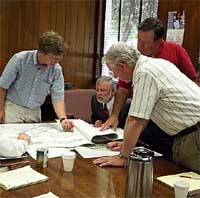Today’s blog is a true story continuation from yesterday – so if you missed it, go back and catch up. The location is masked so as to avoid any possible retribution against the clients who were just trying to do things right. Dealing with your Planning Department can be a hurdle to overcome before you even consider starting in on your new pole building project.
To recap a bit, the clients wanted to plan more room for teenagers by adding new 500 square foot one-story room in an unused portion of their back yard.
At this point in the story, the clients had slogged through mountains of paperwork, repeated “corrections” and months of “less than helpful” assistance from their local Planning Department. They had clearance from the Zoning Conformance Review and sailed through the ARB (Architectural Review Board).
 After the ARB review, they learned they needed a soils report. This was a surprise as all the regulations had been carefully reviewed by the architect, who began his career practicing in this very jurisdiction. While maybe they somehow should have known about this requirement –perhaps there’s a reason for the City staffer’s dismissive comment of “everyone knows” about needing a soils report. This seems to be one of those: “you can’t ask what you don’t know to ask” things.
After the ARB review, they learned they needed a soils report. This was a surprise as all the regulations had been carefully reviewed by the architect, who began his career practicing in this very jurisdiction. While maybe they somehow should have known about this requirement –perhaps there’s a reason for the City staffer’s dismissive comment of “everyone knows” about needing a soils report. This seems to be one of those: “you can’t ask what you don’t know to ask” things.
A simple question was then asked of the person at the Planning Department’s counter: “What should be contained in the soils report?” The official said, “It’s on the Web.” Beyond citing a web address, he briskly declined to offer additional guidance. Unfortunately, after several days of searching, it was concluded that, if it was on the Internet, the client and their architect couldn’t find it. So, the client’s wife returned to City Hall.
This time, she got lucky.
As she stood in line at the Planning Department, the person in front of her asked for information on soils reports. Perhaps the person used the document’s correct technical name.
Amazingly the City employee, without hesitation, reached under the counter and produced a copy of a document which described, in useful detail, what was required in a soils report. So, the client’s wife stepped up to the counter next and asked for the same thing. She was handed the document — by the same guy who, just a week before, could barely manage to grunt about needing to “check the Web”.
The client didn’t object to soils studies in earthquake zones. However, the Plans Department changed nothing in their plans as a result of the report — the main result of this detour was to delay them by another two months. Rather, the client objected to the way the Planning Department thwarted their efforts, early and late in the process, to discover its rules or to glimpse into its black box of decision making in hopes of avoiding yet another unnecessary delay.
Someone’s bound to say the real problem is not the bureaucrat who played dumb but the failure to get a soils report in the first place.
The soils tests were not done when this project was first started because the client mistakenly believed (based on their careful reading of the jurisdiction’s documents) this would be required only for projects over 750 square feet and in hazard zones. Remember their project was about 500 square feet and not in such a zone, according to the State. But, as it turns out, their jurisdiction doesn’t accept the State’s definitions!
This client’s Planning Department makes a nice outward display of trying to help people through its regulatory maze. Describing one such effort on its Planning web site: it says each project is assigned a Project Manager who “will oversee the permit processing of Standard and Complex projects and help applicants understand the City’s requirements and process as early as possible.” It’s a nice gesture, and this client’s project did have a Project Manager.
If this “solution” worked, however, wouldn’t their Project Manager have clued them into the need for the soils report “as early as possible”? Instead, they learned of this rule only after it was too late to avoid another unnecessary delay.
I wish I had a nice ending to this story, but sometimes there just isn’t one. Last I heard, the client didn’t have permission to build their one room addition and they had no plans to move. If they stall long enough, their teens will have grown and left home! Although this particular story is not about a Hansen Buildings project, I’m quick to admit we’ve had a few similar projects with long delays due to similar treatment. Fortunately they are few and far between.
My advice? Educate yourself. Ask for all bulletins, written material from your Planning Department to “make sure you are doing things right”. Also study everything you can on the internet for your local jurisdiction in both the Planning and Building Department sections. And keep your fingers crossed.









